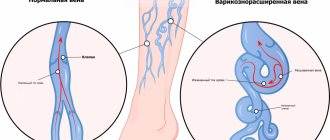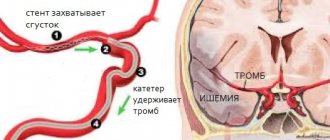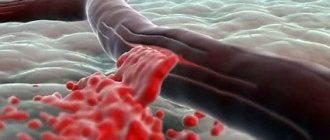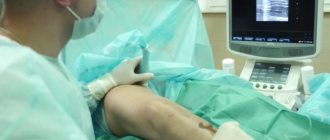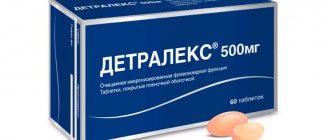Surgery to remove varicose veins on the legs (phlebectomy of the veins of the lower extremities) is one of the oldest forms of surgical treatment of varicose veins of the lower extremities. The earliest description of the procedure was written by Aulus Cornelius Celsus, a Roman medical historian. The first description of phlebectomy using hooks was published in 1545. Modern combined phlebectomy was developed around 1956 by a Swiss dermatologist named Robert Müller.
Microphlebectomy is the medical term used for the procedure of removing an enlarged superficial vein through a tiny incision in the leg. The incisions are so small that they often do not require stitches to close them. A small piece of masking tape is usually enough to cover it. The procedure also helps eliminate pain and improves the appearance of the legs. Surgery for varicose veins of the lower extremities can be used in combination with other procedures such as EVLT (endovenous laser therapy) and sclerotherapy.
Phlebologists at our center perform surgery on the legs for varicose veins, as suggested by the German professor Varadi, who developed his own instruments for performing the operation and formulated the basic postulates of modern microphlebectomy through a puncture. This method has excellent cosmetic results, is painless and does not require hospitalization. At the Innovative Vascular Center, this operation on veins for varicose veins is performed perfectly, and the price of the intervention is affordable for everyone.
How relevant, in your opinion, is surgical treatment of varicose veins today?
Phlebectomy, of course, is relevant, if only because we often encounter advanced forms of varicose veins: people do not always see a doctor on time. This is the first point. Second, surgery is necessary if the patient has certain characteristics of the veins, for example, they are very wide or very tortuous. Then it will not be possible to cure varicose veins using any other methods: neither sclerotherapy nor laser will guarantee that the lumen of the vein is completely closed.
The third important point when we can recommend surgery is a large number of lateral tributaries near the main vein. They can be removed using minimally invasive methods, but this takes a lot of time, which is difficult for the patient. It is in his interests to agree to the operation.
Observation after treatment
Regular classic phlebectomy is rarely needed by patients, as it usually requires an overnight stay in the hospital and 2 to 8 weeks at home. After vein removal in the lower extremities in our center, the patient is allowed to exercise, but should not drive a car for at least a day, since distal motor function may be impaired due to prolonged anesthesia, especially after anesthesia in the popliteal region. The patient is advised to walk for about 10-15 minutes before leaving the clinic.
In the future, you will need to take diosmin medications (detralex); it is not recommended to stand in one place for a long time for 2 weeks. This helps minimize the risk of blood clots forming in the deep veins of the leg. A compression bandage prevents post-operative bleeding and reduces the likelihood of pain, bruising and other complications. The bandages are removed 3-7 days after surgery, but the compression stocking should be worn for an additional 2-4 weeks to minimize bruising and swelling. The wearing time depends on the size of the veins removed and the degree of reflux treatment. Stockings can be removed when taking a shower.
Additional sclerotherapy should be postponed for several weeks and done after the postoperative swelling has disappeared. Many spider veins can spontaneously regress and also disappear spontaneously after the varicose veins are removed through outpatient phlebectomy. Patients should avoid early sun exposure because hyperpigmentation may appear at the puncture or incision site.
The patient is advised to monitor for redness, swelling, suppuration, fever and other signs of infection. If these signs appear, you should immediately consult a doctor.
How is phlebectomy performed?
Each operation has several stages. Crossectomy is a step where the target vein that we remove is ligated and thereby cut off from the deep venous system. Next comes the removal of the trunk - stripping. This can be a Babcock stripping, when the vein is cut out using a special probe. Cryostripping can be performed - an operation in which a cryoprobe is inserted into a vein, the vessel is “frozen” to it using nitrous oxide, and the doctor pulls it out. A distinctive feature of cryostripping is that the patient makes only one incision in the groin area. PIN stripping can also be performed, when the vein is “screwed” inward. The last two methods cause less tissue damage.
At the third stage, a miniphlebectomy is performed - the tributaries of the main vein are removed through punctures.
Possible complications of phlebectomy
Most minor complications are not dangerous and resolve spontaneously. Varicose veins only recur if the source of venous reflux is not removed using endovenous thermal ablation techniques. Laser phlebectomy involves a combination of methods leading to complete recovery.
What can happen after phlebectomy of the great saphenous vein?
- Bleeding, hematoma formation on the thigh (the formation of bruises depends on the correct selection of compression garments),
- Skin pigmentation along the treated venous trunk.
- Other complications, such as accidental nerve damage with sensory impairment or infection, are rare.
- Sometimes skin necrosis may occur.
- Keloids and hypertrophic scars usually do not occur due to the minimal size of the incisions.
- Deep venous thrombosis is observed in isolated cases, since compression stockings are effective methods of prevention.
How long does the recovery period last?
Usually a week. We recommend that patients stay at home, but not in bed, but semi-active. The first three days you can spend about 40% of the time on your feet, and then you need to start “pacing.” On the seventh day, the stitches are removed and the sick leave is closed. For example, we had a patient who had surgery on both legs in turn. And once he completely went through the recovery period, and the second time he had to go to a work meeting after the operation. This leg recovered worse; there were bruises, although he tried to spare the leg and not put stress on it.
Preparing for treatment
Before surgery for varicose veins in the legs, patients should stop taking aspirin or aspirin-related medications for a week before the procedure. They should not eat or drink after midnight on the day of surgery. You should not apply any moisturizers or tanning lotions on the day of your procedure. The patient should arrive at the surgery center approximately one and a half hours before the procedure. He is asked to walk around the room or corridor for about 20 minutes so that the subcutaneous nodes appear. The surgeon marks the contours of varicose conglomerates with a marker. Ultrasound scanning is performed for preoperative marking.
And the last question - what happens if surgery is indicated, but the person does not do it?
I usually say this: “If you don’t deal with the disease, then the disease will deal with you.” If phlebectomy is not performed, varicose veins can lead to thrombophlebitis, and then the veins will have to be removed urgently. Therefore, I recommend that if there are indications for surgery, calmly collect all the tests, prepare and perform it.
Phlebectomy cost:
The main goal of the Phlebology Center clinic is to ensure maximum safety for the patient during surgical treatment. All operations are performed under local anesthesia by surgeons with at least 5 years of experience and only in the presence of an experienced anesthesiologist.
The cost of surgical treatment includes: hospital stay, anesthesia, postoperative dressings, suture removal. After completing the course of treatment, you will receive free six-month observation with ultrasound control.
Without hospitalization and sick leave
When treating varicose veins in our clinic, hospitalization is not necessary. Complex cases of varicose veins are treated by combining laser coagulation and miniphlebotomy. Minimal trauma, as well as a low risk of intervention, allow this operation to be performed in a day hospital. After modern miniphlebectomy, the patient can be sent home half an hour after the intervention. In the postoperative period, you need to lead an active lifestyle, active walking is encouraged. Temporary incapacity for work usually lasts no more than 7 days, then it is possible to begin work.
Removal of leg veins: low prices, high quality!
If you suspect varicose veins, contact our doctor immediately. At an early stage, conservative treatment methods can still be used:
- compression jersey,
- specific drugs,
- exercise therapy complexes.
However, it is often necessary to remove veins in the legs. Prices in our clinic are quite reasonable. You can definitely afford it. In addition, the operation itself is relatively easy for the patient.
Physical therapy after phlebectomy – only with our specialists!
Our clinic does not leave patients immediately after surgery. We provide physical therapy after phlebectomy, which helps you quickly get in shape and return to normal life.
The best exercise therapy specialists will work with you. They will select a set of exercises specifically for you. They will also always be ready to help the patient, tell him how to behave in a given situation, and how best to restore health to his legs.
By listening to them, you can quickly return to your usual rhythm of life. You can continue to enjoy every minute - because now you will have absolutely healthy legs! Our specialists will do everything to achieve this goal! Contact us to make sure of this!
Contraindications to phlebectomy
Phlebectomy has age restrictions and is not indicated for patients over 65 years of age, since with age such surgical intervention is difficult to tolerate due to the presence of a sufficient number of concomitant pathologies. Other contraindications include:
- pregnancy and lactation;
- deep vein thrombosis - late stage of varicose veins;
- inflammatory processes on the legs;
- coronary heart disease, severe arterial hypertension and other cardiovascular diseases;
- atherosclerosis of the lower extremities;
- severe infectious diseases;
- diabetes.
How is surgery performed?
Before removing varicose veins, the patient is prescribed diagnostic procedures. Based on their results, the doctor will determine whether the operation can be performed. An ultrasound examination of the veins and arteries of the lower extremities is mandatory.
What does the combined method consist of?
Classic varicose vein removal involves several surgical techniques. Their main task is to eliminate pathological reverse flow (reflux). This is possible when blood flow is stopped, namely during ligation, removal of a pathologically changed area, or chemical or physical destructive effects on the inner surface of the vessels.
Carrying out a crossectomy
During crossectomy, the altered veins are crossed and ligated at the place where the saphenous vein flows into the femoral vein. The great saphenous vein and its small branches are ligated in the groin. When the operation is completed, the doctor applies a cosmetic suture.
This method is also necessary in cases where there is a threat of thrombophlebitis.
Carrying out safenectomy
This minimally invasive technique for eliminating varicose veins is prescribed if the disease is severe. Additional incisions and punctures are used to remove the affected vein. In addition, large veins are excised. If necessary, the vessel can be removed in parts. At the end of the procedure, stitches are applied.
The purpose of this method is to eliminate the mechanism due to which blood vessels dilate. During the process of such surgical intervention, the central trunk of the affected vein is removed. This operation is effective. However, there are some disadvantages:
- Scars take a long time to heal.
- The rehabilitation period increases.
- A scar will remain on the skin.
Stripping
To carry out such surgery, a special thin probe is used. During the operation, the vein is opened and a metal probe is inserted. With its help, the vein is separated from neighboring tissues. Thanks to this method, it is possible to remove only a specified area where the veins are damaged.
The main advantage is minimal invasiveness. The surgical procedure involves a small puncture, no more than five millimeters. To minimize tissue trauma, a special technique is used, as a result of which the seam is almost invisible. The patient recovers quickly after such an operation.
Phlebectomy: an operation that helps cope with varicose veins!
Phlebectomy is an operation prescribed when less radical methods of treating varicose veins have exhausted themselves. They can no longer prevent further development of the disease. In such situations, the risk of life-threatening complications such as thrombosis or trophic ulcers increases.
The stronger the changes, the more difficult it is to cope with them. In such a situation, the operation cannot be postponed. Phlebectomy involves surgical removal of a section of a vein damaged by disease. Thus, blood flow is normalized. Since only the saphenous veins, which carry only one tenth of the total blood volume, are removed, this procedure is generally safe for the circulatory system.
How is phlebectomy of the lower extremities performed?
Phlebectomy of the lower extremities is performed using specific probes. A blood vessel damaged by varicose veins is ligated and crossed at the point where it flows into a deep vein. A guide probe is then inserted into the vessel through the incisions, and this section is then pulled out.
All work is carried out through miniature incisions followed by cosmetic stitches. Traces after the operation thus remain almost invisible. Sometimes stitches are not applied at all, the edges of the incisions are glued together with special strips of adhesive.
The advantages of receiving surgical care in the Department of Vascular Surgery of the Russian Research Center for Surgery:
- 50 years of experience in conducting operations of this type;
- diseases of the lower extremities are our main profile;
- a fully staffed staff of high-level specialized specialists;
- tens of thousands of successfully performed elective surgeries;
- the latest world-class expert equipment for the diagnosis and surgical correction of varicose veins of the lower extremities;
- the presence of our own patents that modernize the operation, transfer it to the category of minimally invasive, reduce trauma, and significantly minimize damage to health;
- our techniques allow us to achieve a confident aesthetic effect; scars from incisions are almost invisible;
- shortened postoperative rehabilitation;
- long-lasting therapeutic effect for many years.
Indications for combined phlebectomy:
- disruption of blood outflow and tissue trophism;
- extensive progressive varicose veins;
- poor wound healing and trophic ulcers;
- dilated saphenous veins;
- constant pain and heaviness in the legs, swelling, even if there are no external manifestations of varicose veins;
- thrombophlebitis.
Diagnostic methods for examining patients with varicose veins
Our center uses several complementary methods:
- Duplex scanning helps to give a correct initial assessment of the condition of the superficial and deep veins. It is performed using a modern ultrasound machine.
- CT (computed tomography) creates a clearer three-dimensional picture of the vascular bed and is used for an expert opinion when choosing a treatment method for varicose veins.
- Additionally, the degree of damage to blood vessels is assessed using the method using infrared radiation (light reflex rheography).
- By registering fluctuations as the vessels filled with blood change, the tone of small blood vessels is established (plethysmography).
Stages of combined phlebectomy surgery
The operation does not require mandatory general anesthesia. You can limit yourself to epidural spinal anesthesia and intravenous sedation.
The initial stage is a crossectomy, during which the diseased subcutaneous line and the main, deep vessels of the leg are separated in the area of the femoral vein. A small incision is made in the groin fold. If the operation is performed not on the great saphenous vein, but on the small saphenous vein, an incision is made under the knee. In both cases, using modern suture materials, such manipulations leave virtually no scars.
Then comes the next stage: inversion or invagination stripping: a tiny incision is made in the groin area to remove the trunk of the great saphenous vein using a particularly thin probe (PIN - stripping, PIN - probe). The probe is passed through the part of the vein to be removed and brought out in the lower leg area. Where the head of the probe is located, the vein is excised to remove and tie a surgical thread on the vein. The vein, without much effort, is removed from the puncture on the lower leg, pulled out by the thread. Thus, the tissue is less injured, there is no need to make a full incision, which means the aesthetic effect will be higher.
At the last stage of the operation, tributaries deformed by varicose veins and incompetent perforating veins are stopped and removed, for which particularly thin instrumentation is used. The hook-like instruments are so thin that they do not require incisions; they are used to hook and extract veins, and the mini punctures are microscopic and subsequently heal without a scar.
Our specialists are constantly improving the tactics of combined phlebectomy, supplementing it with new methods of treating varicose veins, including minimally invasive techniques. Thus, the rehabilitation period is shortened, healing is accelerated, and surgical trauma is minimized.
The average duration of the operation is 1 hour 30 minutes.
Postoperative period
The average hospital stay is from 2 to 5 days. The duration depends on private factors, including the general health of the patient, the extent of damage to varicose veins of the lower extremities and, consequently, the volume of surgical procedures performed.
To speed up rehabilitation, physical therapy exercises in combination with self-massage and wearing compression garments may be indicated.
Within 2-4 weeks, the seals and marks from the operation disappear. A scheduled examination by a specialist is two weeks after the operation.
Other phlebectomy methods
There is also a set of methods used in the surgical treatment of varicose veins, which are conventionally called “vein-saving”.
These methods are aimed at restoring the functions of the valve apparatus and preventing the further development of varicose veins.
To do this, various synthetic cuffs or fascia are used, which are fixed around non-functioning valves and segments of venous lines that need treatment.
Unfortunately, vein-sparing operations do not have a pronounced effect in the long term.
Thus, the 5-year relapse rate of the disease exceeds 50%. [/td]
Phlebectomy, miniphlebectomy, microphlebectomy at GUTA CLINIC
Angiosurgeons and phlebologists at GUTA CLINIC have extensive experience in performing phlebectomies
and
miniphlebectomies of
varying degrees of complexity. Our specialists use the latest surgical equipment and suture materials, so the risk of complications during surgery is minimal.
Question about choosing a treatment method for varicose veins
(
phlebectomy, miniphlebectomy
) is accepted on the basis of examination data, as well as according to the individual indications of the patient.
Postoperative period
After surgery, an elastic bandage or elastic stocking is placed on the limb to provide uniform compression. The legs are given an elevated position. It is recommended to take venotonic drugs. You are allowed to walk the very next day. Early activity and compression therapy make it possible to normalize venous outflow and prevent thrombus formation.
To perform phlebectomy, the Scientific and Practical Center for Surgery uses high-tech devices and modern techniques. Surgeons at our center pay special attention to the aesthetic side of the issue, so the incisions made are minimal and do not leave scars.
Rehabilitation period after phlebectomy
During the entire rehabilitation period it is recommended:
- use elastic bandages immediately after surgery, then use compression garments and elastic knitwear;
- monitor your diet;
- do not take a hot shower, refuse to visit the sauna and steam bath;
- perform a set of special exercise therapy exercises;
- limit physical activity, stop playing sports;
- Avoid mechanical impact on your feet (for example, do not use a rough washcloth).
The duration of the rehabilitation period is a fairly individual indicator, which depends on the number of veins removed, the complexity of the operation performed, the presence of concomitant pathologies, the general health of the patient and his age. The minimum duration of the recovery period is 2 weeks.
| Phlebectomy | |
| Mini phlebectomy 1 degree of complexity | RUB 35,050 |
| Mini phlebectomy 2nd degree of complexity | RUB 42,300 |
| Phlebectomy 1 degree of complexity | RUB 86,500 |
| Phlebectomy 2nd degree of complexity | RUB 105,100 |
| Juviderm Volift with lidocaine (anesthetic) (1 ml) | RUB 19,000 — RUB 21,000 — RUB 14,999 (Limited) |
| Perfecta (1 ml) | RUB 18,000 – RUB 12,999 (Limited) |
| Restyline (1 ml) | RUB 12,500 |
When is phlebectomy prohibited?
There are a number of factors in the presence of which removal of varicose veins is prohibited. These factors include:
- Diagnosed with severe hypertension or ischemic disease.
- Advanced stage of varicose veins, complicated by lymphostasis.
- A severe infectious process is occurring in the body.
- In the presence of severe combined pathology, which is inflammatory in nature.
- If the patient is elderly.
- When carrying a child (pregnancy)
- For stroke, heart attack, diabetes.





